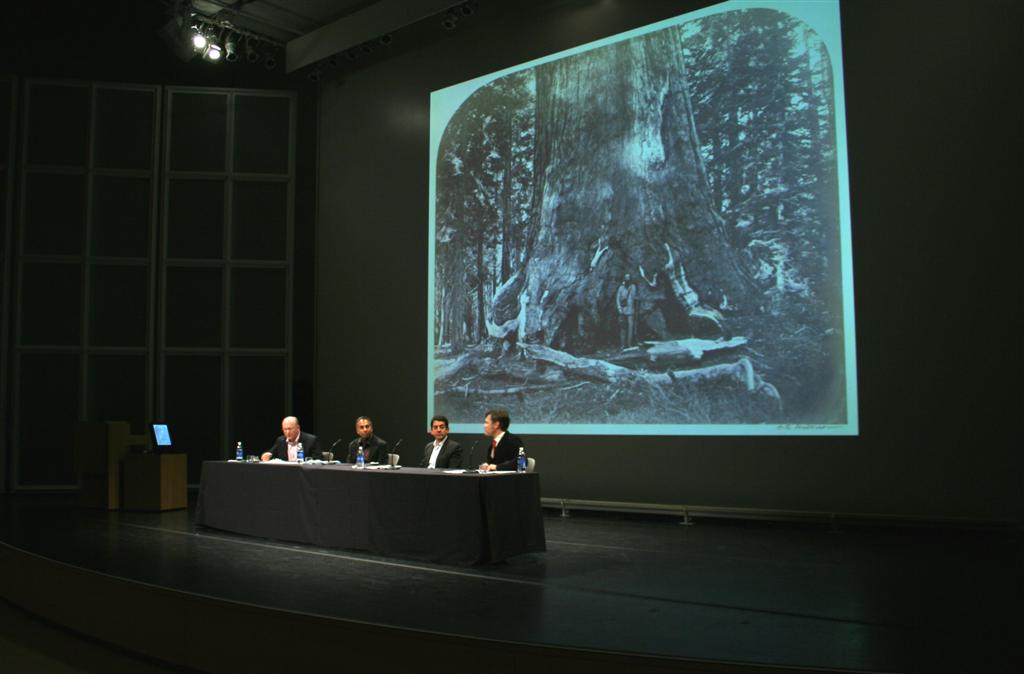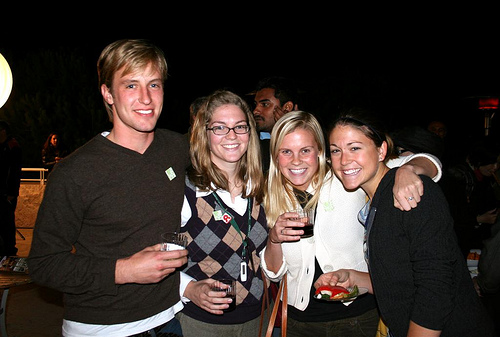
Talking about the relationship between immigrants and the Californian landscape, moderator Bob Sipchen told the audience at the Getty Center, is a bit like talking about how birds get along with the sky.
“It was almost redundant,” said Sipchen, editor of Sierra magazine. “They are inexorably linked.”
But Sipchen and the panelists — UC San Diego’s Nayan Shah, Brown University’s Matthew Garcia, and Getty Center fellow Ken Gonzales-Day — told a more complex story, of waves of migrant laborers drawn by the promise of a lush California, of booming towns whose inhabitants saw and shaped their new home in the image of the land they left, of the sometimes violent reaction to those newcomers, and of their absence from the best-remembered photographs of the time.
Caption this
 Many of the most famous photographs of mid-nineteenth century California are by Carleton Watkins, a New York boy who migrated to California via Panama. He took large photographs of the Yosemite Valley, producing beautiful work at great effort and cost in a medium not yet considered art. Watkins hulked a 75-pound camera “the size of a Volkswagen” (in Gonzales-Day’s words) and a portable dark room up and down steep dirt paths, taking shots that countless tourists retake, knowingly or otherwise, today.
Many of the most famous photographs of mid-nineteenth century California are by Carleton Watkins, a New York boy who migrated to California via Panama. He took large photographs of the Yosemite Valley, producing beautiful work at great effort and cost in a medium not yet considered art. Watkins hulked a 75-pound camera “the size of a Volkswagen” (in Gonzales-Day’s words) and a portable dark room up and down steep dirt paths, taking shots that countless tourists retake, knowingly or otherwise, today.
Said tourists, as likely owners of tiny cameras carried in purses and back pockets, probably wouldn’t fully appreciate Watkins’ work without an explanation. But as Gonzales-Day and Garcia both noted, a photograph cannot explain itself, and further, explanation is only part of the process of creating the meaning of a picture. The other part relies on the interpretation and understanding of the viewer.
In Watkins’ time, as Shah pointed out, photographs were taken primarily for evidence: Watkins found himself in Mariposa because the owner of mines there wanted clear shots for a property dispute. “If [Watkins] studied art, he’d be a painter or a sculptor,” Gonzales-Day said. He “would not be a photographer.” Today, of course, his photographs are on view at the Getty.
Missing persons
Although less known for his city work, Watkins did take some shots of San Francisco’s burgeoning Chinatown. As Shah noted, in 1870, 30% of the working male population of California was Chinese. Watkins’ photographs of the earliest Chinese restaurants, of a well-dressed Chinese woman, and of Chinese laborers building a railroad bridge speak to a history that, the panelists said, is erased in landscape photographs and art. An empty shot of citrus groves, for example, doesn’t convey the labor – by Mexicans, Chinese, Japanese, Sikh, Slavic, and Armenian workers – that produced the groves.
“[The groves] look natural, like they’re supposed to be like that,” Garcia said. “California in particular is associated with this idea of fecundity, of naturally growing fruits and vegetables that require very little labor. A lot of that comes out of the photography that was produced in the 19th century.”
Watkins’ photographs, some initially taken for geographical surveys, became promotional material. A migrant might be told he “could survive and thrive as a ‘ten-acre man,’” whereas in other parts of the country he would need ten times that acreage to make a decent living, Garcia said.
As one audience member noted in Q&A, California at once suppressed histories and nourished them. That is, migrants responded to the richness of California imagery, and recreated in it the mountains and rivers of their home countries. But their stories weren’t part of the imagined west, Gonzales-Day said. And some smaller immigrant communities, like South Asians, Shah said, were further submerged because they intermarried.
Seeing tragedy
Labor and people were not the only thing erased in California imagery and history. Vigilantism was common in mid-19th-century California, before laws were well applied and executed. Photographs and diaries of the time, some of which Gonzales-Day displayed and discussed with the audience, record lynching, more associated with the South than with California or downtown Los Angeles. One such spot is marked, in Placerville, California, but most are unmarked or long lost, said Gonzales-Day, who has photographed several of the sites, to remember rather than erase the history they’ve witnessed.
The story of immigrants and the landscape isn’t all despair and gloom, as Sipchen noted in conclusion. A new biography of John Muir notes that the famous naturalist met a “dark-skinned” man hiking Eaton Canyon near Pasadena, and felt an instant kinship when he discovered how appreciative the man was of the place. “A passion for nature can still draw people together,” Sipchen said, noting he too, one week earlier, had hiked the same path and, surrounded by soft murmurs of Southern Californians speaking in foreign tongues, saw the same crescent moon.
Watch the video here.
See more photos here.
*Photos by Aaron Salcido.




Send A Letter To the Editors